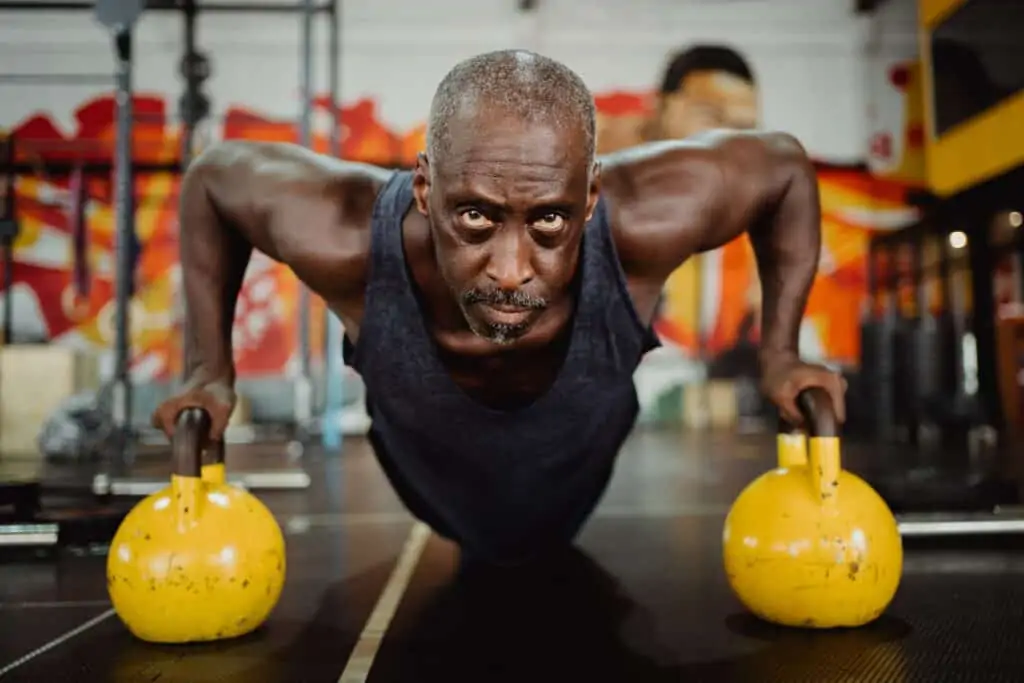Strength Training for Seniors?
Medical Definition of strength training: A system of physical conditioning in which muscles are exercised by being worked against an opposing force (as by lifting weights) to increase strength. While everyone loses some muscle mass with age, it’s possible to slow or reverse that loss with regular strength training.
Table of Contents
We all get weaker as we get older, and our muscles shrink, and this process accelerates as we get older.
This is an unavoidable consequence of doing less and less activity as time passes.
We become weaker because we do not perform tasks that keep our muscles strong. The loss of muscle mass and strength can be prevented! Furthermore, any muscle loss is reversible too.
There are various kinds of exercises, but the importance of strength training cannot be overstated. It can be weight lifting, using resistance bands, or doing bodyweight exercises. You only need to be regular at it.
Unfortunately, most seniors do not want to participate in this activity because they fear being hurt. Most of these unfound fears result from low activity and are unwarranted. If you are doing it properly, initially under a coach’s guidance, preferably, you won’t get hurt. And think of the positives associated.
We have so many ailments associated with old age that can be easily avoided with regular strength training.
Sarcopenia is the loss of muscle mass that occurs due to aging. It’s natural to lose muscle mass when you get older. Sarcopenia, on the other hand, refers to abnormally extreme muscle loss.
Osteoporosis – The term translates to “porous bones.” It occurs when bones’ protein and mineral content, specifically calcium, is depleted. Bone mass, and hence bone strength, deteriorates over time. As a result, bones become brittle and easily break.
Rheumatoid Arthritis – Rheumatoid arthritis is a long-term inflammatory condition that affects more than your joints. The condition can harm various body systems in some people, including the skin, eyes, lungs, heart, and blood vessels.
Fibromyalgia – Muscle or musculoskeletal discomfort, stiffness, and localized tenderness at particular points on the body define this rheumatic condition.
Type 2 Diabetes is when cells cannot properly use blood sugar (glucose) for energy. When cells become insensitive to insulin, blood sugar levels are dangerously high.
What is common in all these illnesses except for these bombastic words?
All these can be cured or kept under check with strength training.
Strength Training for Seniors
Yes, all these and many more
Lifting weights is beneficial to people with arthritis. Weight lifting is a strength training that keeps your muscles strong and supports your joints. Lifting weights, on the other hand, would not aggravate your arthritis. Whether you have osteoarthritis or an autoimmune inflammatory form like rheumatoid arthritis or psoriatic arthritis, muscle-building exercises are an important part of your arthritis management strategy. Your doctor will surely suggest them.
Strength training should help people with fibromyalgia increase their quality of life. Resistance exercises and weight lifting are examples of strength training. It’s critical to increase intensity when using light weights gradually. Strength training should help compensate for the loss of muscle mass and strength of aging.
Studies show that strength training is as effective as aerobic exercise at improving insulin sensitivity. People with type 2 diabetes should begin a strength training program to assist with blood sugar control, according to the American Diabetes Association.
According to the US Department of Health and Human Services, all adults should do some strength training targeting all main muscle groups at least twice a week. That is even more important for seniors.
Why is Strength Training Important for Seniors?
Our bodies change as we get older, sometimes in ways we don’t like. Even healthy, normal aging includes a slower metabolism. Muscle mass, strength, bone density, aerobic capacity, and response time all reduce as you age. Body fat and bone porosity are also increasing. Our muscles stiffen, and our reflexes slow.
Strength training slows down these processes and minimizes their effect on our bodies.
Bone Fractures: How to Avoid Them
Because of the loss of bone density, bone fractures are more common in older adults. Evidence shows that strength and weight lifting will help you gain bone density.
Strength Training boosts Muscle Mass
Due to inactivity and disuse, we lose about 25% of our muscle mass when 70 years old. Strength training like weight lifting and resistance training is best for reversing muscle loss and increasing strength.

Functional Movement Enhancement
Regular strength training will help older adults gain mobility, walk farther, and even decrease canes and walkers’ needs. Strengthening the body also helps with a variety of other functional movements. As a result, life becomes simpler and more activities become available.
Body Composition Improvement
In particular, women in their fifties and sixties tend to gain fat while losing muscle mass. They are at risk of developing chronic diseases as a result of this. Strength training aids in the maintenance of healthy body composition.
Improves Mental Health
Mental health is just as critical as physical health regarding aging. As you get older, you’re more likely to experience loneliness and social isolation, as well as depression and other mental health matters. Building strength improves mood and overall quality of life by increasing mobility and function and improving overall health.
Reduces joint stiffness and swelling
According to a study published in the journal Rheumatology, strengthening the muscle groups around affected joints increased function and reduced pain in individuals with osteoarthritis.
Improvement in Bone Strength
Inactivity due to joint pain and aging may contribute to bone loss, especially in women. Strength training increases bone density and lowers the risk of osteoporosis by lightly stressing your bones.
Assists in Maintaining Healthy weight
Additionally, you lose muscle mass when you get older, which slows your metabolism and can lead to weight gain.
A combination of cardio and weight training is required to prevent pound creep caused by a slower metabolism. Cardio burns more calories during the workout, and strength training burns calories for a longer period.
Improves balance
Strengthening your core should help you improve your balance and coordination and keep you from falling. Being stronger also makes it easier carrying groceries.
Anil’s infectious enthusiasm and wealth of knowledge make him a natural motivator. Through his guidance and support, Anil has helped countless individuals transform their lives, empowering them to lead more vibrant and fulfilling lives.




